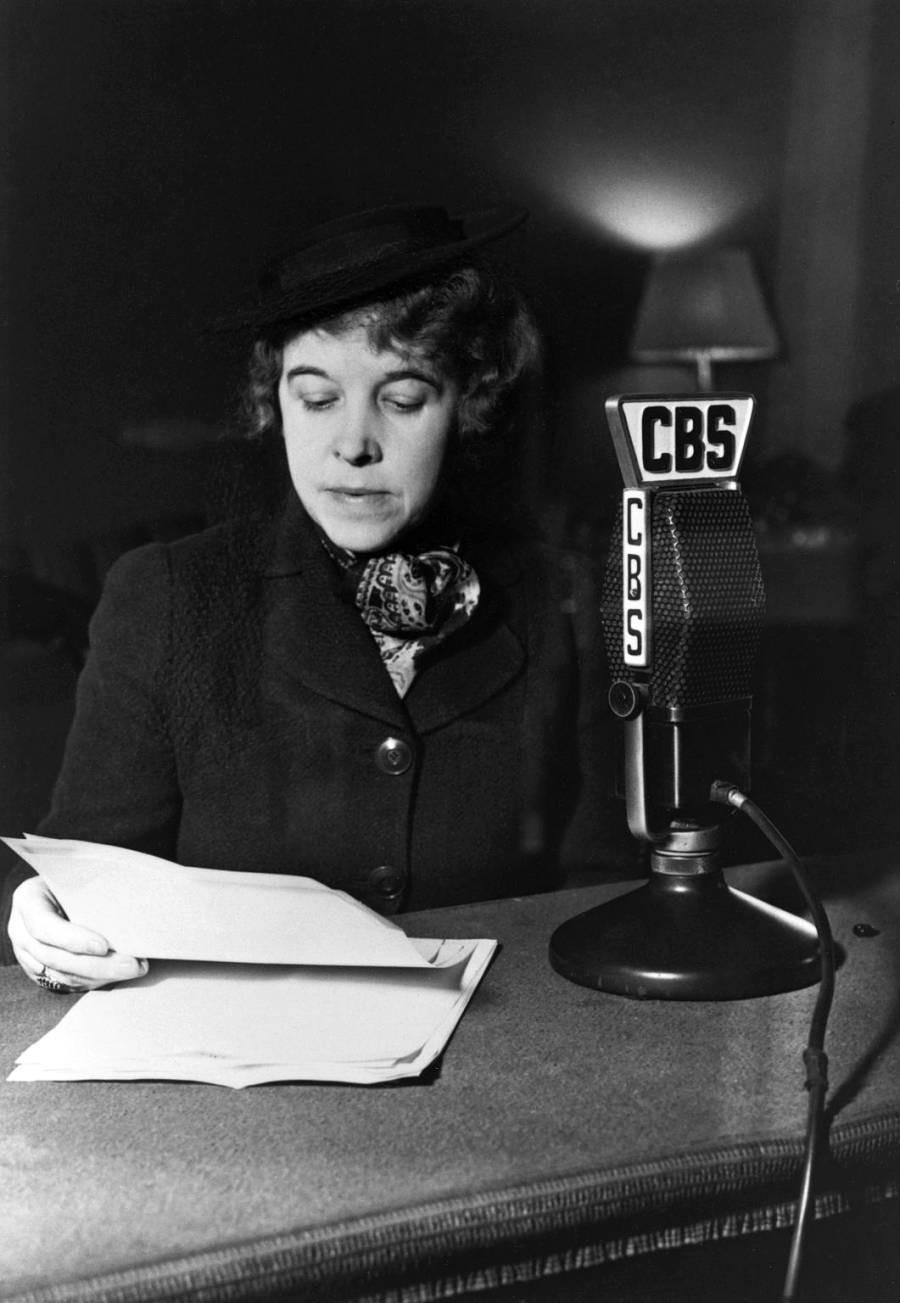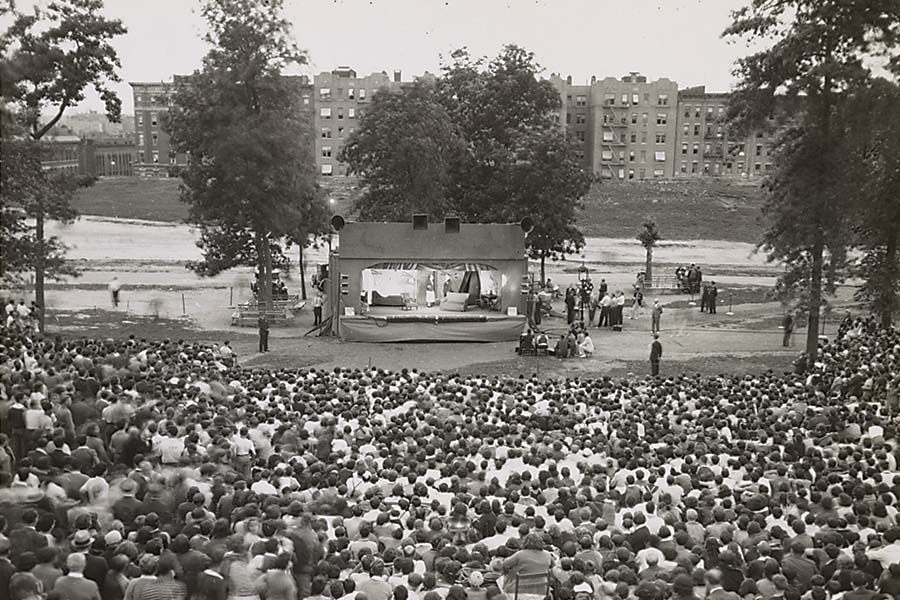“Our whole emphasis in the theatre enterprises which we are about to undertake should be on rethinking rather than on remembering. The good old days may have been very good days indeed, but they are gone. New days are upon us and the plays that we do and the ways that we do them should be informed by our consciousness of the art and economics of 1935…The theatre must become conscious of the implications of the changing social order, or the changing social older will ignore, and rightly, the implications of the theatre.”
— Hallie Flanagan, Arena: The History of the Federal Theatre
“We let out these works on the vote of the people.”
— Motto of the Federal Theatre Project, from an inscription at the third century B.C. Greek theatre on Delos
We cannot return to normal—it’s already gone. With COVID-19, economic collapse, and the promise of further disruptions from future pandemics and climate change, we are entering a new era in American history. Our infrastructures have been ravaged. Our ability to physically congregate feels uncomfortably fragile.
This has also opened up the space and time for protest. Catalyzed by the police murder of George Floyd in Minneapolis, millions across the country have taken to the streets despite the pandemic to hold the nation’s attention on the long-unaddressed problem of institutional racism and force a conversation on the nature of policing and incarceration, striking at the mechanisms of racial oppression so many of us take for granted and have for too long worked to uphold.
With industries disrupted across the board, people have more time to reflect on the inequalities and traumas of the structures they work under. This is no less true for the theatre industry. With initiatives like the We See You White American Theater campaign, artists of color have directed a spotlight on the ways the theatre industry has stifled them and are demanding fundamental change. Not only must we ask how theatre will survive, we must also ask what theatre even is and should be in and beyond this age of social distancing and revolution.
Even before the crisis, discussions about the state of the theatre industry have tended to follow a particular path: a cathartic airing of grievances followed by exasperated resignation when idealism hits the wall of capital. A theatre must be a business, ergo it must work within these parameters. But what happens when the economy as we know it cannot function in the face of the challenges of the time? What happens when we acknowledge the racism foundational to our social and economic system?
The late Mark Fisher once wrote: “It is easier to imagine the end of the world than the end of capitalism.” He coined the term “Capitalist Realism,” referring to the ideology of pessimism that says: This is the best we can do, there is nothing beyond it. It often comes from, or boils down to, arguments about “human nature.” But in the arts, a field fueled by dreams, resigning ourselves to a fixed view of human nature would be a terrible mistake. As artists, when have we ever been satisfied with “this is the way things are”? What use would our creations be if not for the capacity for change? We need to apply the imagination we put into our work to the structures on which our industry is built.
Artists in America have long maintained a precarious and exploited position, competing for limited grants and paid opportunities, often doing significant amounts of free labor before they “make it.” This means their source of income must be distinct from their artistic practice and must allow, in some way, for time to create. Healthcare tied to employment or union work weeks often becomes a frustrating boondoggle, forcing artists into difficult decisions and gaps in coverage. Lack of free or even affordable housing in the most active theatre centers puts life-or-death pressure on artists. The prohibitive barrier of grad school tuition and living expenses keeps many from the exclusive training, access, and connections that often jumpstart careers. And even after navigating these roadblocks, the rarity of a living wage in a career that requires so much investment makes it untenable for many. All of this gives structural advantages to those who have familial financial support or some kind of prior safety net over those who come from poor and working-class backgrounds.
Now, with the resulting crisis from COVID-19, many of the “day jobs” artists rely on are gone or are prohibitively dangerous, and a great number of them may not come back, adding greater pressure on the labor market in the oncoming recovery. Unless you happen to have landed a gig you can continue remotely, you are likely unemployed and facing rent, either now or in a lump sum at the end of a moratorium, at which point there’s no guarantee your financial situation will have improved.
There have been some promising organic adaptations to the situation. Many have taken to Zoom, created opportunities for rapid-response theatre, and pooled resources to compensate artists who have lost valuable income and exposure with initiatives like Artist Relief. Despite the obstacles, theatre maintains its communal instinct. It is that instinct that should guide us as we make sense of where we are and where we need to go.
But we need to think big and demand more—and we have a model in our own past that can help us. The St. Louis Federal Reserve projects 47 million lost jobs and a nearly 40 percent unemployment rate, worse than the Great Depression of the 1930s. As in that time, we also see a flourishing of radical organizing across the country and open critique of how our institutions function. Looking toward a similar crisis, we might start by revisiting the ways artists organized during that time, using their successes and limitations to guide us in this new one.
In response to the widespread misery of the Great Depression, the government, led by Franklin Delano Roosevelt in the executive branch, enacted perhaps the most ambitious social reform program in American history. This became known as the New Deal, a collection of interlinked programs designed to combat mass unemployment and establish social and economic stability during an unprecedented economic crisis. The Works Progress Administration, headed by Harry Hopkins, a close advisor to Roosevelt, spearheaded job-related initiatives. Part of that program was the Federal Arts Project, which sought to put unemployed artists to work. He tapped his close friend Hallie Flanagan—an accomplished multidisciplinary experimental theatre artist, professor of drama at Vassar, and the first woman to win the Guggenheim Fellowship—to run the Federal Theatre Project. Though it had its limitations, the Federal Theatre Project provides a useful model for mobilizing our institutions in a major economic crisis, not only to provide financial security to artists but to change the relationship Americans have to art and artists over the long term.

Flanagan saw the FTP not only as an economic relief program for artists but also as an opportunity to expand the art form, increase access, and introduce live performance to communities who might not have previously had the chance to experience it. At its height the FTP employed 13,000 people in 31 states. Flanagan’s particular background as a Midwesterner and an experimental artist made her the right person to construct a program which reflected regional differences and incorporated a wide range of theatrical traditions, informed in part by her experience with workers’ theatre companies in Europe. Between its three-pronged attack—the Federal Players, the Negro Repertory Company, and the Variety/Vaudeville company—the program powered an explosion of creativity and political action.
This time saw the development of canonical white writers like Eugene O’Neill, who fled New York after a cold reception to his play Days Without End but found himself produced widely all over the country with the FTP, and Arthur Miller, who turned down a lucrative Hollywood paycheck to join the project, as well as Orson Welles, whose Mercury Theatre made challenging, boundary-pushing work, including a famous production of Macbeth with the New York City Negro Theatre Unit, known informally as “Voodoo Macbeth.”
It was the Negro Theatre Units who were the center of innovation and radical art during the period. While they did face censorship from white conservatives and liberals alike, Black artists were enabled by the support of the FTP to make radical work for Black communities, and often in places where social and economic forces prevented the development of institutionalized Black theatres. Federal largesse also meant that FTP’s promise of free or nearly free theatre gave access to mixed audiences of whites, Blacks, and immigrant workers. This not only introduced communities to forms they might have been previously unfamiliar with, it also introduced communities to each other and their different ways of spectating theatre. White audiences were not used to the more active and vocal Black audience; in turn, Black audiences may have been surprised and inspired by positive reactions to Black heroism onstage. Negro Units also staged their own versions of white dramas, adapted in wildly creative ways, reconstructing these stories to speak to the issues of the Black community.
Given today’s politics, the idea of a massive stimulus package for artists sounds impossible, even laughable. But there is no better time to demand what is necessary than a time when the stakes are most keenly felt. The Great Depression saw such major reforms not because of a natural, inevitable change but because an organized, militant movement of people put pressure on the system. The relationship between theatre and the labor movement, so integral to these changes, reached a peak during this time.
During the Popular Front era, in which the International Communist Party directed all members to collaborate with non-communists against fascism, there was strong, militant action on the ground all across the West, and in the U.S. Inspired by work in Germany and the Soviet Union in the 1920s, the American theatre movement of the 1930s brought together activists, writers, actors, and labor organizers who shared the belief that theatre could contribute to political movements.
The Minneapolis Theatre Unit, which was active between 1935-1939, was one remarkable example of how Popular Front politics accomplished this aim. It benefitted from a fruitful if chaotic relationship between the militant communists of the Farmer-Labor Union and the more conservative Unitarian Church, who allowed the union to use their space for rehearsals and performances. The Union was also mobile, performing in union halls and other unconventional spaces to reach the community. Much of their work dealt with labor issues and left-wing politics, though they were limited by a condition imposed by the Unitarians not to directly promote strikes or be an exclusively labor theatre.
Producing work that was more congenial to middle-class issues did manage to expand their audience and encourage understanding among the unions, who would buy up performances, and other members of the community. Still, individual members of the company attended strikes, and many productions supported radical causes. A production of Clifford Odets’s Till the Day I Die raised money for the Scottsboro Defense Committee.
In the past few decades, neoliberal policies have decimated the power of unions, and we have seen the further atomization of social movements. It is urgent that artists link their advocacy for themselves and their work with the issues affecting everyone, especially the most marginalized in society here and abroad. Our efforts must be part of a larger political project, one that collaborates with and is further embedded in an international labor movement and which stands with oppressed communities. We must make the larger structural issues of social and economic inequality our issues too. The world we must win can only come from a movement that puts pressure on the overarching structures—a movement in which all of us are bound up with one another.
Art must be integrated into society, and must be treated and supported as a public good, not as a business in which everyone fends for themselves. This is not just about creating art about issues or communities, but integrating our artistic practices into the causes of social and economic justice. This means that barriers to participation must be eliminated for artists and audiences in marginalized communities. This also means artists must make themselves visible in the major political battles that affect us, as well as in the communities we hope to serve.
At a time when a global pandemic once again places the greatest burden on Black, Indigenous, and Latinx communities, we must center their unique experiences with the American system, acute and long-term. At a time when frontline workers are risking their lives to keep the system going, often in deplorable conditions without proper protective equipment or distancing protocols, we should find ways to support and participate in strikes, of which there have been 151 across the U.S. since March 1.
How do we stand with immigrant communities as they face repression, deportation, and deplorable conditions in detention? How do we stand with and for Black communities struggling with social and economic devastation, police brutality, and mass incarceration? We can do writing workshops in prisons, but what can we do for the incarcerated who have been particularly devastated by the virus? How do we imagine a world without the racist system of policing? How do we fight for oppressed people both here and around the world struggling against the actions of our government? How can theatre artists today link up with on-the-ground direct action organizations and communities where they live?
I wish I could give more concrete answers. I am just one artist trying to make sense of this world. But as a collective, we must face these questions together and determine how we will materially fight for social and economic justice. While we’re adapting to the digital realm, staying connected through livestreamed plays and panels, this is a time for reflection and planning for the future. What kind of world do we want and how do we fit in it? We must be a part of the struggle and think of ourselves as political actors. We must rebuild our institutional structures, we must open up our spaces, and we must be in the streets.
Aeneas Sagar Hemphill, a multiracial South Asian American playwright and actor based in New York City and Washington, D.C., makes work that investigates the personal, communal, and historical ghosts that haunt our lives and communities. He is a founding member of Argo Collective, a collaborator with Argument Sessions, and currently works as program assistant and instructor with Young Playwrights Theater.


